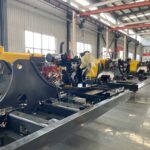Introduction
Wheel dozers provide invaluable grading, pushing, and earthmoving capabilities on construction sites. Their articulated frames and precision blade controls excel at finishing grades and clearing land. However, dozer ownership also comes with financial, safety, and operational risks to manage.
As medium-sized equipment investments ranging $150,000 – $300,000, wheel dozers represent a significant liability for equipment yards. Failures disabling machines or resulting in accidents carry severe consequences. By understanding the top five ownership risks, owners can minimize expense headaches and safety incidents over their dozer‘s lifetime.
Unexpected Repair Bills

With advanced powerplants and hydraulic systems, wheel dozers carry high maintenance costs and repair bills compared to compact equipment. Their articulated chassis also wear quickly from the demands of dozing and turning. Excessive repairs cutting into profits remains an ever-present risk with ownership.
Frequent inspections and preventative maintenance provides the best hedge against surprise downtime. Still, owners must budget for periodic part replacements and minor failures inevitable with machines experiencing endless vibration and strain.
Common major repair costs like overhauls or powertrain rebuilds can run $15,000 – $30,000. Even a blown hose or electrical issue easily racks up $2,000+ in parts and labor. One accident or failed turbo can erase a year’s profits.
Table 1. Average Repair Costs on Wheel Dozers
| Repair | Cost |
|---|---|
| Engine Overhaul | |
| Powertrain Rebuild | |
| ECU Replacement | |
| Hydraulic Pump | |
| Radiator |
Machine Theft

Because of their easy portability and high resale value, wheel dozers attract relatively high theft rates. Their articulated frames allow quick loading onto trailers without ramps. Recovery rates for stolen equipment remain very low, making machine theft an ever-present risk.
Owners relying on equipment for daily business suffer severe profit loss when stolen units disappear for weeks or permanently. Various deterrent methods provide some protection:
- Locking hitches or chains
- Wheel boot locks
- Hidden GPS trackers
- Security alarm systems
But determined thieves often circumvent these measures with time and effort. Ultimately insurance coverage, rental reimbursements, or backup units offer the only financial remedy from theft losses.
Environmental Spills
As with any heavy machinery, wheel dozers pose environmental dangers from potential hydraulic fluid or diesel spills. Their reservoirs carry 20-50 gallons of fluids containing toxic compounds and groundwater contaminants.
A single ruptured fuel tank or severed hydraulic line could spill gallons of hazardous liquids. Without proper spill containment and cleanup, severe EPA fines up to $50,000 per violation apply. Spatial sediment contamination also triggers expensive environmental remediation.
Owners must implement rigorous fluid monitoring, spill training, and maintenance protocols to minimize ecological risks. Daily checks for leaks paired with prompt fluid changes prevents most spills. But the possibility always exists for a loose fitting or failed hose spewing onto the ground before operators notice.
Operator Injuries
Despite their medium size, wheel dozers weigh over 10 tons with formidable crushing potential all around. Unwary operators and grounds workers risk death or dismemberment around rotating shafts, blades, and tracks.
Blind spots also limit visibility of people or objects nearby while working. Inexperienced operators prove even more vulnerable to accidents like rollovers. These dangers contribute to dozens of operator fatalities and hundreds of serious injuries involving dozers annually.
Rigorous site safety protocols and updated operator training reduces risks tremendously. Pre-operation checklists reminding drivers to survey surroundings also help avoid mistakes. But owner liability continues for any negligence resulting in worker casualties.
Overeager Operators
Operator errors pose universal risks with any heavy machinery – but wheel dozers undergo particular stress from overeager drivers. Their articulated chassis tempt speedy travel and sharp turns exceeding mechanical limits.
Overzealous dozing also strains engines and hydraulic systems past capacity. Such impatience damages equipment components faster while raising safety issues from unbalanced machines. Devices like engine governors deter excess RPMs, yet no system oversight substitutes for proper operating habits.
Alongside formal training programs, veteran mentoring goes far to instill safe equipment handling basics in all operators. Emphasizing gentle acceleration/braking, maintaining track tension, and careful slope traversing prevents incidents from inexperienced over-stressing.
Table 2. Common Wheel Dozer Operating Limits
| Parameter | Limit | Caution Zone |
|---|---|---|
| Travel Speed | 7 mph | Above 5 mph |
| Engine RPM | 2,200 rpm | Above 2,000 rpm |
| Slope Angle | 30 degrees | Over 20 degrees |
| Turn Radius | 12 feet | Under 16 feet |
Conclusion
While wheel dozers provide immense productivity on construction sites, their ownership carries major financial, environmental, and safety risks as well. From six-figure repair bills to fatalties and spill incidents, owners must implement rigorous protocols minimizing these threats.
Prioritizing preventative maintenance, leakage avoidance, turnover prevention, and updated training benefits all involved. When operated responsibly by properly skilled drivers, wheel dozers deliver years of reliable service with minimal headaches. Ignore their many risks, however, and endless headaches await down the road.
FAQ
What is the average lifespan of a well maintained wheel dozer?
Between periodic repairs and rebuilds, a properly maintained wheel dozer averages 20,000 – 30,000 operating hours over 20-25 years before retiring.
What insurance policies help cover wheel dozer ownership risks?
Comprehensive machine insurance with theft, operators liability, and environmental spill coverage all make excellent supplements to general liability policies.
What safety accessories help reduce operator injuries?
Adding protective guards around shafts, flashers increasing visibility, and proximity alarm systems all significantly improve safety for those working around operating wheel dozers.






-150x150.webp)
